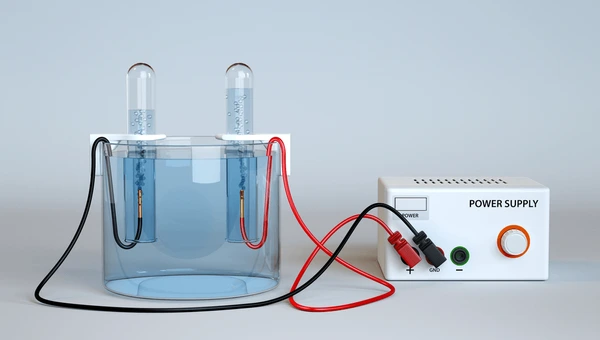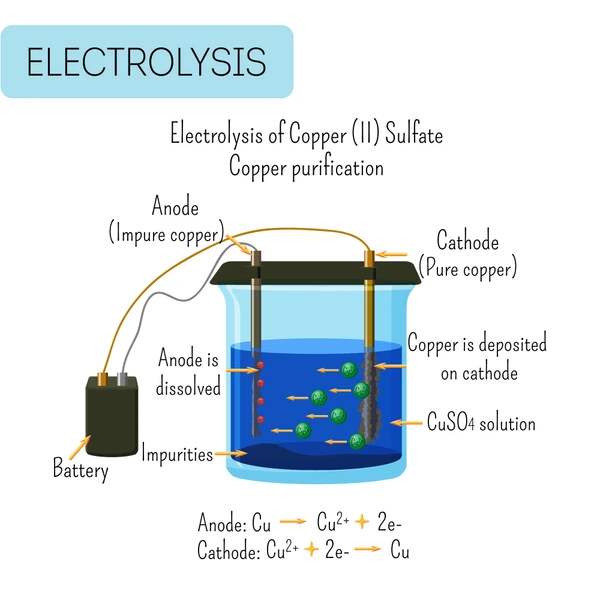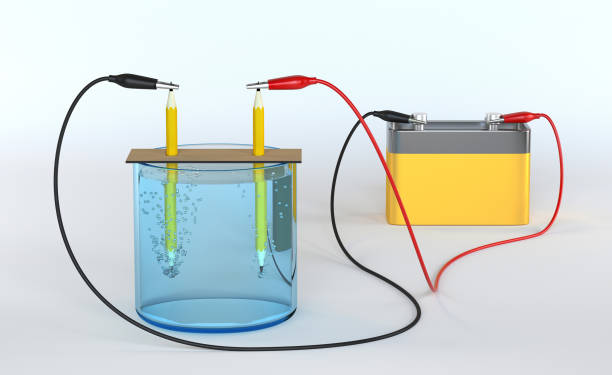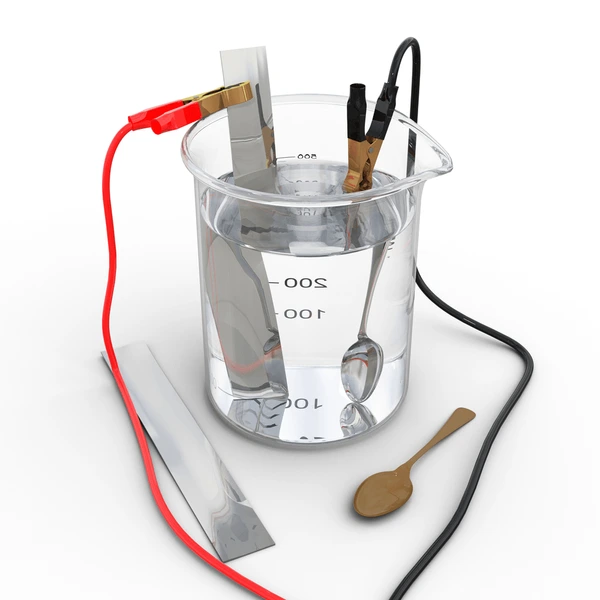Electrolysis is a fundamental concept of chemistry and industry, serving an essential role in numerous applications, such as metal extraction and water purification. In this detailed guide, we delve into the science of electrolysis, its mechanisms, and its diverse applications in today’s society.
Whether you’re a student, a chemistry lover, or a professional, this article will offer you valuable insights into the electrolysis process.
Introduction to Electrolysis

Electrolysis is a chemical process that uses an electric current to drive a non-spontaneous reaction. It typically involves the decomposition of ionic compounds in molten or aqueous form. By applying electricity, the compound breaks down into its constituent elements.
The term comes from Greek words: electro, meaning electricity, and lysis, meaning to break apart.
How Electrolysis Works
Electrolysis requires a few key components:
- Electrolyte: An ionic substance that conducts electricity when molten or dissolved in water.
- Electrodes: Conductive rods (usually graphite or metal) that allow current to flow into and out of the electrolyte electrochemical cell.
- Anode: The positive electrode where oxidation occurs.
- Cathode: The negative electrode where reduction takes place.
- Power Supply: A direct current (DC) source that drives the reaction.
Basic Reaction Setup:
When the DC power source is connected, positive cations migrate toward the cathode to gain electrons (reduction), and negative anions move toward the anode to lose electrons (oxidation).
Electrolysis Reactions and Equations
Let’s consider the electrolysis of molten sodium chloride (NaCl):
- At the cathode:
Na⁺ + e⁻ → Na (reduction) - At the anode:
2Cl⁻ → Cl₂ + 2e⁻ (oxidation)
Overall Reaction:
2NaCl → 2Na + Cl₂
This reaction is used industrially to produce metallic sodium and chlorine gas.
Electrolysis of water
It is a chemical process that uses electricity to break down water (H₂O) into its basic elements: hydrogen and oxygen gases.
In this process:
- Water acts as the electrolyte, often with a small amount of acid or salt added to improve conductivity.
- A direct current (DC) power source is connected to two electrodes in the water.
- At the cathode (negative electrode), hydrogen gas is produced.
- At the anode (positive electrode), oxygen gas is released.
Chemical Equation:
2H₂O(l) → 2H₂(g) + O₂(g)
This process is important for producing clean hydrogen fuel, which is being explored as a sustainable energy source for the future.
Electrolysis of Aqueous Solutions
When electrolyzing aqueous ionic solutions, water also participates in the reactions. The ions present compete with H⁺ and OH⁻ ions from water.
For example, electrolysis of copper(II) sulfate (CuSO₄) solution using inert electrodes:

- At the cathode:
Cu²⁺ + 2e⁻ → Cu (copper is deposited) - At the anode:
2H₂O → O₂ + 4H⁺ + 4e⁻ (oxygen gas is evolved)
Overall Reaction:
2CuSO₄ + 2H₂O → 2Cu + O₂ + 2H₂SO₄
Components of Electrolysis

To understand electrolysis, let’s look at its main parts:
- Electrolyte: A substance that conducts electricity by producing free-moving ions when melted or dissolved in water.
- Electrodes: Two solid conductors- anode (positive) and cathode (negative)-placed in the electrolyte.
- Power Supply: Provides the direct current needed to drive the reaction.
Factors Affecting Electrolysis
Several factors affect the efficiency and results of the electrolysis process.
- Nature of Electrolyte: Determines the types of ions available for reaction.
- Electrode Material: Inert vs reactive electrodes can alter the products.
- Concentration of Ions: Affects the competition between different ions.
- Current and Voltage: Higher current speeds up the reaction but may affect selectivity.
Industrial Applications of Electrolysis
1. Electroplating

Electrolysis is used to coat objects with a thin layer of metal, enhancing appearance and resistance to corrosion. Common examples include gold plating, silver plating, and chromium plating.
2. Extraction of Metals
Electrolysis of molten ores allows the extraction of highly reactive metals such as aluminum and sodium.
Bauxite (Al₂O₃), the ore of aluminum, undergoes electrolysis after purification:
- At the cathode:
Al³⁺ + 3e⁻ → Al - At the anode:
O²⁻ → O₂ + 2e⁻
This process is energy-intensive but essential for metal production.
3. Electrorefining
Used to purify impure metals, such as copper. In this process, impure copper acts as the anode, while pure copper is positioned as the cathode. During electrolysis, pure copper is deposited onto the cathode, and the impurities either detach from the anode or remain suspended in the solution.
4. Production of Gases
Electrolysis of water breaks it into hydrogen and oxygen:
- Cathode:
2H₂O + 2e⁻ → H₂ + 2OH⁻ - Anode:
2H₂O → O₂ + 4H⁺ + 4e⁻
This method is gaining traction for green hydrogen production.
Main Elements of Electrolysis and Their Roles
| Component | Role |
|---|---|
| Electrolyte | Conducts electricity via ions |
| Anode (+) | Oxidation occurs (loss of electrons) |
| Cathode (–) | Reduction occurs (gain of electrons) |
| Power Supply | Provides the DC current |
Advantages of Electrolysis
- High purity products: Especially in metal refining.
- Environmentally friendly: When powered by renewable energy.
- Versatile applications: From industrial production to small-scale labs.
Disadvantages of Electrolysis
- High energy consumption: Requires significant electrical power.
- Cost-intensive setup: Especially for large-scale applications.
- Electrode wear: Especially if reactive electrodes are used.
Examples of Electrolysis
- Hydrogen fuel cells: Reverse electrolysis to produce electricity.
- Chlor-alkali process: Produces chlorine, hydrogen, and sodium hydroxide from brine.
- Hair removal: Electrolysis is used in dermatology for permanent hair removal.
Electrolysis in Everyday Life
Many household products are made using electrolysis, including:
- Aluminum foil
- Purified drinking water
- Electroplated jewelry
- Batteries and rechargeable cells
Safety Precautions in Electrolysis
- Always wear protective gloves and goggles.
- Use fume hoods when evolving gases like chlorine.
- Avoid contact with hot molten substances.
- Ensure proper electrical insulation to prevent shocks.
Future of Electrolysis
With increasing demand for sustainable and green technologies, electrolysis is expected to play a crucial role in:
- Decarbonizing industries
- Hydrogen economy
- Renewable energy storage
Innovations like solid oxide electrolysis cells (SOECs) and photoelectrolysis are paving the way for higher efficiency and integration with solar energy.
It is a versatile and essential process used to separate elements, extract valuable metals, purify substances, and even produce clean energy. Whether you’re a student, educator, or working in the industry, gaining a clear understanding of how electrolysis works can unlock numerous scientific and real-world applications.
As technology evolves, it is expected to play a vital role in clean energy, especially in the production of green hydrogen, making it a process of both scientific interest and environmental importance.
Conclusion
It is far more than just a school chemistry experiment. It is a vital industrial process with profound implications for energy, manufacturing, and the environment. From extracting metals to producing clean hydrogen, its impact continues to expand with scientific progress.
What is the process of electrolysis?
Whether you’re a student, a chemistry lover, or a professional, this article will offer you valuable insights into this process.

It is a chemical process that uses an electric current to drive a non-spontaneous reaction. It typically involves the decomposition of ionic compounds in molten or aqueous form. By applying electricity, the compound breaks down into its constituent elements.
The term comes from Greek words: electro, meaning electricity, and lysis, meaning to break apart.
It is required a few key components:
Electrolyte: An ionic substance that conducts electricity when molten or dissolved in water.
Electrodes: Conductive rods (usually graphite or metal) that allow current to flow into and out of the electrolyte electrochemical cell. Anode: The positive electrode where oxidation occurs.
Cathode: The negative electrode where reduction takes place.
Power Supply: A direct current (DC) source that drives the reaction.
Basic Reaction Setup:
When the DC power source is connected, positive cations migrate toward the cathode to gain electrons (reduction), and negative anions move toward the anode to lose electrons (oxidation).
Reactions and Equations
Let’s consider of molten sodium chloride (NaCl):
At the cathode:
Na⁺ + e⁻ → Na (reduction)
At the anode:
2Cl⁻ → Cl₂ + 2e⁻ (oxidation)
Overall Reaction:
2NaCl → 2Na + Cl₂
This reaction is used industrially to produce metallic sodium and chlorine gas.
Electrolyzing of Aqueous Solutions
When electrolyzing aqueous ionic solutions, water also participates in the reactions. The ions present compete with H⁺ and OH⁻ ions from water.
For example, electrolysis of copper(II) sulfate (CuSO₄) solution using inert electrodes:

At the cathode:
Cu²⁺ + 2e⁻ → Cu (copper is deposited)
At the anode:
2H₂O → O₂ + 4H⁺ + 4e⁻ (oxygen gas is evolved)
Overall Reaction:
2CuSO₄ + 2H₂O → 2Cu + O₂ + 2H₂SO₄
Components used

To understand electrolysis, let’s look at its main parts:
Electrolyte: A substance that conducts electricity by producing free-moving ions when melted or dissolved in water.
Electrodes: Two solid conductors-anode (positive) and cathode (negative)-placed in the electrolyte.
Power Supply: Provides the direct current needed to drive the reaction.
Factors Affecting this process
Several factors affect the efficiency and results of process.
Nature of Electrolyte: Determines the types of ions available for reaction.
Electrode Material: Inert vs reactive electrodes can alter the products.
Concentration of Ions: Affects the competition between different ions.
Current and Voltage: Higher current speeds up the reaction but may affect selectivity.
Industrial Applications
1. Electroplating

It is used to coat objects with a thin layer of metal, enhancing appearance and resistance to corrosion. Common examples include gold plating, silver plating, and chromium plating.
2. Extraction of Metals
Electrolys of molten ores allow the extraction of highly reactive metals such as aluminum and sodium.
Bauxite (Al₂O₃), the ore of aluminum, undergoes electrolysis after purification:
At the cathode:
Al³⁺ + 3e⁻ → Al
At the anode:
O²⁻ → O₂ + 2e⁻
This process is energy-intensive but essential for metal production.
3. Electrorefining
Used to purify impure metals, such as copper. In this process, impure copper acts as the anode, while pure copper is positioned as the cathode. During this, pure copper is deposited onto the cathode, and the impurities either detach from the anode or remain suspended in the solution.
4. Production of Gases
Electrolysis of water breaks it into hydrogen and oxygen:
Cathode:
2H₂O + 2e⁻ → H₂ + 2OH⁻
Anode:
2H₂O → O₂ + 4H⁺ + 4e⁻
This method is gaining traction for green hydrogen production.
Main Elements and their Roles
| Component | Role |
|---|---|
| Electrolyte | Conducts electricity via ions |
| Anode (+) | Oxidation occurs (loss of electrons) |
| Cathode (–) | Reduction occurs (gain of electrons) |
| Power Supply | Provides the DC current |
Advantages
High purity products: Especially in metal refining.
Environmentally friendly: When powered by renewable energy.
Versatile applications: From industrial production to small-scale labs.
Disadvantages
High energy consumption: Requires significant electrical power.
Cost-intensive setup: Especially for large-scale applications.
Electrode wear: Especially if reactive electrodes are used.
Examples
Hydrogen fuel cells: Reverse electrolysis to produce electricity.
Chlor-alkali process: Produces chlorine, hydrogen, and sodium hydroxide from brine.
Hair removal: Electrolysis is used in dermatology for permanent hair removal.
In Everyday Life
Many household products are made using electrolysis, including:
Aluminum foil
Purified drinking water
Electroplated jewelry
Batteries and rechargeable cells
Safety Precautions
Always wear protective gloves and goggles.
Use fume hoods when evolving gases like chlorine.
Avoid contact with hot molten substances.
Ensure proper electrical insulation to prevent shocks.
Future
With increasing demand for sustainable and green technologies, electrolysis is expected to play a crucial role in:
Decarbonizing industries
Hydrogen economy
Renewable energy storage
Innovations like solid oxide electrolysis cells (SOECs) and photoelectrolysis are paving the way for higher efficiency and integration with solar energy.
It is a versatile and essential process used to separate elements, extract valuable metals, purify substances, and even produce clean energy. Whether you’re a student, educator, or working in the industry, gaining a clear understanding of how electrolysis works can unlock numerous scientific and real-world applications.
As technology evolves, It is expected to play a vital role in clean energy, especially in the production of green hydrogen, making it a process of both scientific interest and environmental importance.
Conclusion
It is far more than just a school chemistry experiment. It is a vital industrial process with profound implications for energy, manufacturing, and the environment. From extracting metals to producing clean hydrogen, its impact continues to expand with scientific progress.
What is the electrolysis of water?
It is a chemical process that uses electricity to break down water (H₂O) into its basic elements: hydrogen and oxygen gases.
In this process:
Water acts as the electrolyte, often with a small amount of acid or salt added to improve conductivity.
A direct current (DC) power source is connected to two electrodes in the water.
At the cathode (negative electrode), hydrogen gas is produced.
At the anode (positive electrode), oxygen gas is released.
Chemical Equation:
2H₂O(l) → 2H₂(g) + O₂(g)
This process is important for producing clean hydrogen fuel, which is being explored as a sustainable energy source for the future.
What is the principle of electrolysis?
Cathode:
2H₂O + 2e⁻ → H₂ + 2OH⁻
Anode:
2H₂O → O₂ + 4H⁺ + 4e⁻
This method is gaining traction for green hydrogen production.
What are the applications of electrolysis?
1. Electroplating

It is used to coat objects with a thin layer of metal, enhancing appearance and resistance to corrosion. Common examples include gold plating, silver plating, and chromium plating.
2. Extraction of Metals
Molten ores allow highly reactive metals such as aluminum and sodium extraction.
Bauxite (Al₂O₃), the ore of aluminum, undergoes it after purification:
At the cathode:
Al³⁺ + 3e⁻ → Al
At the anode:
O²⁻ → O₂ + 2e⁻
This process is energy-intensive but essential for metal production.
3. Electrorefining
Used to purify impure metals, such as copper. In this process, impure copper acts as the anode, while pure copper is positioned as the cathode. During electrolysis, pure copper is deposited onto the cathode, and the impurities either detach from the anode or remain suspended in the solution.
4. Production of Gases
Electrolysis of water breaks it into hydrogen and oxygen:
Cathode:
2H₂O + 2e⁻ → H₂ + 2OH⁻
Anode:
2H₂O → O₂ + 4H⁺ + 4e⁻
This method is gaining traction for green hydrogen production.
Explain the electrolysis process.
Whether you’re a student, a chemistry lover, or a professional, this article will offer you valuable insights into this process.

It is a chemical process that uses an electric current to drive a non-spontaneous reaction. It typically involves the decomposition of ionic compounds in molten or aqueous form. By applying electricity, the compound breaks down into its constituent elements.
The term comes from Greek words: electro, meaning electricity, and lysis, meaning to break apart.
It is required a few key components:
Electrolyte: An ionic substance that conducts electricity when molten or dissolved in water.
Electrodes: Conductive rods (usually graphite or metal) that allow current to flow into and out of the electrolyte electrochemical cell. Anode: The positive electrode where oxidation occurs.
Cathode: The negative electrode where reduction takes place.
Power Supply: A direct current (DC) source that drives the reaction.
Basic Reaction Setup:
When the DC power source is connected, positive cations migrate toward the cathode to gain electrons (reduction), and negative anions move toward the anode to lose electrons (oxidation).
Reactions and Equations
Let’s consider of molten sodium chloride (NaCl):
At the cathode:
Na⁺ + e⁻ → Na (reduction)
At the anode:
2Cl⁻ → Cl₂ + 2e⁻ (oxidation)
Overall Reaction:
2NaCl → 2Na + Cl₂
This reaction is used industrially to produce metallic sodium and chlorine gas.
Electrolyzing of Aqueous Solutions
When electrolyzing aqueous ionic solutions, water also participates in the reactions. The ions present compete with H⁺ and OH⁻ ions from water.
For example, electrolysis of copper(II) sulfate (CuSO₄) solution using inert electrodes:

At the cathode:
Cu²⁺ + 2e⁻ → Cu (copper is deposited)
At the anode:
2H₂O → O₂ + 4H⁺ + 4e⁻ (oxygen gas is evolved)
Overall Reaction:
2CuSO₄ + 2H₂O → 2Cu + O₂ + 2H₂SO₄
Components used

To understand electrolysis, let’s look at its main parts:
Electrolyte: A substance that conducts electricity by producing free-moving ions when melted or dissolved in water.
Electrodes: Two solid conductors-anode (positive) and cathode (negative)-placed in the electrolyte.
Power Supply: Provides the direct current needed to drive the reaction.
Factors Affecting this process
Several factors affect the efficiency and results of process.
Nature of Electrolyte: Determines the types of ions available for reaction.
Electrode Material: Inert vs reactive electrodes can alter the products.
Concentration of Ions: Affects the competition between different ions.
Current and Voltage: Higher current speeds up the reaction but may affect selectivity.
Industrial Applications
1. Electroplating

It is used to coat objects with a thin layer of metal, enhancing appearance and resistance to corrosion. Common examples include gold plating, silver plating, and chromium plating.
2. Extraction of Metals
Electrolysis of molten ores allow the extraction of highly reactive metals such as aluminum and sodium.
Bauxite (Al₂O₃), the ore of aluminum, undergoes electrolysis after purification:
At the cathode:
Al³⁺ + 3e⁻ → Al
At the anode:
O²⁻ → O₂ + 2e⁻
This process is energy-intensive but essential for metal production.
3. Electrorefining
Used to purify impure metals, such as copper. In this process, impure copper acts as the anode, while pure copper is positioned as the cathode. During this, pure copper is deposited onto the cathode, and the impurities either detach from the anode or remain suspended in the solution.
4. Production of Gases
Electrolysis of water breaks it into hydrogen and oxygen:
Cathode:
2H₂O + 2e⁻ → H₂ + 2OH⁻
Anode:
2H₂O → O₂ + 4H⁺ + 4e⁻
This method is gaining traction for green hydrogen production.
Main Elements and their Roles
| Component | Role |
|---|---|
| Electrolyte | Conducts electricity via ions |
| Anode (+) | Oxidation occurs (loss of electrons) |
| Cathode (–) | Reduction occurs (gain of electrons) |
| Power Supply | Provides the DC current |
Advantages
High purity products: Especially in metal refining.
Environmentally friendly: When powered by renewable energy.
Versatile applications: From industrial production to small-scale labs.
Disadvantages
High energy consumption: Requires significant electrical power.
Cost-intensive setup: Especially for large-scale applications.
Electrode wear: Especially if reactive electrodes are used.
Examples
Hydrogen fuel cells: Reverse electrolysis to produce electricity.
Chlor-alkali process: Produces chlorine, hydrogen, and sodium hydroxide from brine.
Hair removal: Electrolysis is used in dermatology for permanent hair removal.
In Everyday Life
Many household products are made using electrolysis, including:
Aluminum foil
Purified drinking water
Electroplated jewelry
Batteries and rechargeable cells
Safety Precautions
Always wear protective gloves and goggles.
Use fume hoods when evolving gases like chlorine.
Avoid contact with hot molten substances.
Ensure proper electrical insulation to prevent shocks.
Future
With increasing demand for sustainable and green technologies, electrolysis is expected to play a crucial role in:
Decarbonizing industries
Hydrogen economy
Renewable energy storage
Innovations like solid oxide electrolysis cells (SOECs) and photoelectrolysis are paving the way for higher efficiency and integration with solar energy.
It is a versatile and essential process used to separate elements, extract valuable metals, purify substances, and even produce clean energy. Whether you’re a student, educator, or working in the industry, gaining a clear understanding of how electrolysis works can unlock numerous scientific and real-world applications.
As technology evolves, It is expected to play a vital role in clean energy, especially in producing green hydrogen, making it a process of both scientific interest and environmental importance.
Conclusion
It is far more than just a school chemistry experiment. It is a vital industrial process with profound implications for energy, manufacturing, and the environment. From extracting metals to producing clean hydrogen, its impact continues to expand with scientific progress.

1 thought on “Electrolysis”